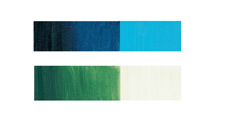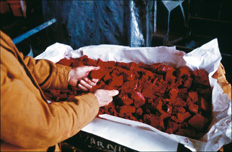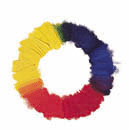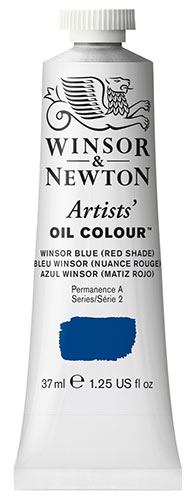Artists' Oils

Range Information
Artists' Oil Colour is unmatched for its purity, quality and reliability - a success which is reflected in its world-wide reputation amongst professional artists. It has 133 colours in the range, offering the widest spectrum of all the Winsor & Newton oil ranges. The full range of 133 colours are available in 37ml tubes and 40 colours are available in 200ml tubes.
Formulation
Every Winsor & Newton Artists' Oil Colour is individually formulated to enhance each pigment's natural characteristics and ensure stability of colour. By exercising maximum quality control throughout all stages of manufacture, selecting the most suitable drying oils and method of pigment dispersion, the unique individual properties of each colour are preserved.
Combined with over 170 years of manufacturing and quality control expertise, the formulation of Artist's Oil Colour ensures the best raw materials are made into the World's Finest Colours.
Pigments
Artists' Oil Colour uses the highest level of pigmentation consistent with the broadest handling properties. The quantity of pigment used provides covering power and tinting strength; leading to the saying "artists' quality goes further".

Winsor Blue (Green Shade) - high tinting strength, Terre Verte - low tinting strength
Covering Power not only comes from pigment strength, but also from the greater thickness of colour, which results from the stiff consistency associated with Artists' Oil Colour. Covering power is particularly linked to the most opaque colours like Titanium White and the Cadmiums.
Like all raw materials, pigments are available in various grades. We use only the purest of pigments ensuring the cleanest, brightest colours, which in turn produce the best colour mixtures.

Assessing pigment in the factory
Our quality standards include the use of single pigments wherever possible to create individual colours. Combined with strength of colour, single pigments provide a wide colour range in themselves and offer cleaner, brighter mixtures with an infinite range of hues. This is particularly important for greens, violets and oranges. Single pigment 'secondaries' considerably broaden the artists' available spectrum. There are 80 single pigment colours in the range.
Widest Spectrum
We are famous for providing the widest spectrum of colours within our ranges. The colours are selected according to mass tone [colour from tube], undertone [bias of colour when in a thin film], strength and relative opacity. This provides the largest number of colour positions and an infinite number of colour mixtures. A total of 100 different pigments are used to produce 119 colours.
As the cost of the pigments used varies, so does the price charged for the colour. Therefore we have grouped colours together in 4 'series'. The higher the series number, the higher the price. You can find the series number both on the colour chart and on the tube.
Transparency & Opacity
.gif) Pigments vary in their transparency by nature. On the Winsor & Newton Artists’ Oil Colour chart and individual colour pages of this site, the transparent colours are marked with
Pigments vary in their transparency by nature. On the Winsor & Newton Artists’ Oil Colour chart and individual colour pages of this site, the transparent colours are marked with  or T, the semi-transparent colours are marked
or T, the semi-transparent colours are marked  or ST. The relatively semiopaque colours are marked with
or ST. The relatively semiopaque colours are marked with  or SO and the opaque colours are marked with
or SO and the opaque colours are marked with  or O.
or O.
Remember that the level of transparency of a colour is relative to other colours. Transparent colours are used for glazing and tinting, providing optical colour mixtures and depth of colour to the painting surface. Opaque colours cover well, give flat areas of colour and obscure/mask the underlayers of the painting.
Artists' Oil Colour is formulated to reflect the characteristics of each of the various pigments, ensuring that synthetic organics such as Phthalocyanines and Quinacridones [ie. "Winsor" or "Permanent colours"] deliver maximum transparency, whilst Cadmiums and Earth colours offer excellent opacity.
Viscosity/Consistency
The buttery consistency of Artists' Oil Colour, together with the smell of linseed oil, are the two characteristics most admired by oil painters. These qualities are unbeaten by other media. The stiff consistency of Winsor & Newton colours can retain brush or palette knife marks or it can be thinned to the very finest of glazes.
While Artists' Oil Colour is formulated to provide as even a reflective surface as possible, it's important to note that the reflective quality of the oil film is affected by a wide variety of factors. Because each pigment requires differing volumes of oil in formulation, the surface sheen may differ from colour to colour. The addition of solvent, and the use of additive mediums will alter surface sheen as well as the ground used.
Permanence
Since 1832 we have been developing permanent alternatives for the less durable traditional colours, without compromising the handling properties of the oil colours. As a result, the permanence of the colour range as a whole has been improved beyond the dreams of past painters.
Of the 119 colours in the range, 119 are now classed as 'permanent for artists' use' [AA or A ratings from Winsor & Newton] which aids in the longevity of paintings. Although Alizarin Crimson is only given a "B" rating ( moderately durable), it has been part of Artists' Oil Colour for over 130 years and is still considered a key colour by many contemporary artists.
Drying Times
Working with oil colour allows for a certain degree of flexibility while painting, as it takes longer to dry than other media. Should you want to alter your work days into a project, oil colour allows for such changes to be made. Its malleable nature, in addition to the depth, purity, and vibrancy of pigment quality, makes oil colour a favourite among some artists.
Familiarising yourself with the properties of various oil colours and their drying rates will help you achieve the best results, in addition to avoiding cracking and other mishaps. Generally oil colours become ‘touch-dry’ in thin films within two to 12 days, but different reactions of each pigment when mixed with oil results in varying drying times which will affect your work.
We’ve rounded up critical information about each of Winsor & Newton's key oil colour ranges and the drying rates of various colours for your convenience. Read on and print out the charts when choosing your oil colours of choice for easy reference!
Fast Drying [around two days]: | Medium drying [around five days]: | Slow drying [more than five days]: |
Permanent Mauve [manganese] | Winsor Blues and Greens [Phthalocyanines] | Winsor Yellows and Orange (arylides) |
Liquin Original is the perfect medium to speed the drying time of oil colour. It will speed the drying by approximately 50%.
Whites in the Range
 White has been used by artists for thousands of years, helping to provide contrast within a work, as well as conveying moods such as cleanliness, lightness and innocence. It also dominates some of the 20th century’s finest works such as Mondrian’s ‘Composition With Yellow, Blue and Red.’
White has been used by artists for thousands of years, helping to provide contrast within a work, as well as conveying moods such as cleanliness, lightness and innocence. It also dominates some of the 20th century’s finest works such as Mondrian’s ‘Composition With Yellow, Blue and Red.’
There are lots of whites to choose from in the Winsor & Newton Oil Colour ranges to allow you to create and experiment with qualities such as covering power, non-yellowing and transparency.
During the production process all of the pigments used to create Winsor & Newton whites are milled with Safflower oil because of its paler colour and its non-yellowing characteristics.
Titanium White Flake White Hue Zinc White Transparent White Iridescent White |
Mixing Colours
 The three primary colours in the Artists' Oil Colour range are Transparent Yellow, Winsor Blue [Red Shade] and Permanent Rose. These colours are the best selection when only three colours are used. We recommend Winsor Lemon, Winsor Yellow, French Ultramarine, Winsor Blue [Green Shade], Permanent Rose and Cadmium Red when using a six colour mixing system.
The three primary colours in the Artists' Oil Colour range are Transparent Yellow, Winsor Blue [Red Shade] and Permanent Rose. These colours are the best selection when only three colours are used. We recommend Winsor Lemon, Winsor Yellow, French Ultramarine, Winsor Blue [Green Shade], Permanent Rose and Cadmium Red when using a six colour mixing system.











